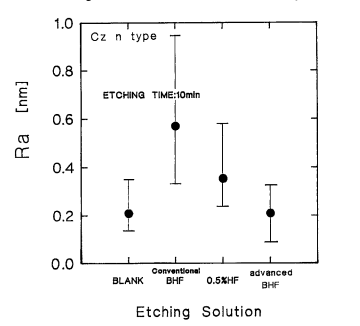ABSTRACT
process on the surtace microroughness of S wafers wzas studied.using C7T7The etect ofthewetchemicalc eaningand EPI wafers.has been shown that the surface microroughness affects the dielectric breakdown characteristics of theoxide: the dielectricoreakdown orthe oxidedegradesas the microrouehnessof the Si substrate increases. The microroughness on the Si substrate surface andthe oxide surlace was evalatedwtD 8scanning tunneling microscope (STMand an atomic force microscope (AFMThe5UracemcrOrOUneSSwas found to increase in wet chemical processing.inparticular in NHOH-HOHO cleaning(APM cleaning).It hasbeen shown that the microroughness does not increaseat all if the NHOH mixing ratio in NHOHHO-HO solution issuppressedat a low level: NHOH-H0.05:1:5 (conventional mixing raio is 1:1:5), and the room temperature ultrapure water rinsing is introduced rieht after theAPM cleaning. At the same time, the APM cleaning with its NHOH mixing ratio suppressed at the low level has beenfound very effective to remove particles and metallic impurities from the Si surface.The increase of microroughness dueto the APM cleaning varies among the wafer types; little increase is observed on EPI wafer but significant increase is obhowever, that the CZ and FZ wafers which go through the wet oxidation atserved on CZ and FZ wafers. It has been found1000°C for over 4 h, can suppress the increase of microroughness in the APM cleaning at almost the same level as the EPlwafer. This because the interstitial Si atoms generated in the wet oxidation fill the Si vacancy. In the case of the n-type CZwafer, the surface microroughness is also observed to increase in the DHF cleaning. It has been revealed the addition otH,O, of over 0.5% to the DHF solution can completely suppress this microroughness increase.
In the manufacturing process of sub-micron and deepsub-micron (ULSI) devices, it has been pointed out thatthe cleanliness of the substrate surface is the key factor interms of the device performance and the reliability: the ultraclean wafer surface must be free from particles, organicimpurities, metallic impurities, native oxide, adsorbed im-purity molecules, and surface microroughness12, The con-ventional cleaning process has been based upon the con-cept of the RCA cleaning which is efficient in removingsuch contaminants on the substrate surface as particles,organic materials, and metallic impurities>s.
Experimental
In these experiments, CZ (100) wafer and the FZ (100)doped with phosphorous (P) and boron (B) were usedTheir resistivity is 8-12 cm and the parameter of averagesurface microroughness (Ra) is 0.15-020 nm.
In order to evaluate the surface microroughness withSTM, the native oxide on the Si surface must be removed.The native oxide was removed in the 1 min immersion intoan advanced BHF (HF conc.:0.17%) which had a surfactant(400 ppm) added and had the low NHF concentration of17% to suppress the surface microroughness increase dur-ing the removal process'4,s

Fig1
It was investigated next which process of the RCAcleaning affects the surface microroughness. Figure 3 presents the surface microroughness of the n-type CZ waferwhen it was treated with the HSOHO cleaning (SPMcleaning) with the mixing ratio of 4:1 and the HCl--HOHO cleaning (HPM cleaning) with the mixing ratio of1:1:6. Figure 4 shows the surface microroughness of n-typeCZ wafer, p-type CZ wafer, and n-type FZ wafer whichwere treated with the APM cleaning with the mixing ratiovarying from 1:1:5 to 0.05:1:5.The temperature during theAPM cleaning was kept at 80-90C.
Removal efficiency of particles and metallic impuri.ties.- The previous section described that the surfacesmoothness can be maintained by reducing the NHOHmixing ratio and by introducing the room temperature ul.trapure water rinsing.
Acknowledgments
Authors would like to express their sincere thanks to Dr.T.Abe of Shin-etsu Semiconductor, Inc, supplying im-proved wafers for this research work. This research hasbeen mainly carried out in the Superclean room of Labora-tory for Microelectronics, Research Institute of ElectricalCommunication,Tohoku University. Ifit is noted that preceding work of importance related to this article is due toour incomplete survey references, It would be greatly ap-preciated if such information or comments are provided tothe authors.
上一篇: 单晶片兆波系统中的二氧化碳溶解水清洗方法
下一篇: EUV掩模的碳污染对光刻性能的影响